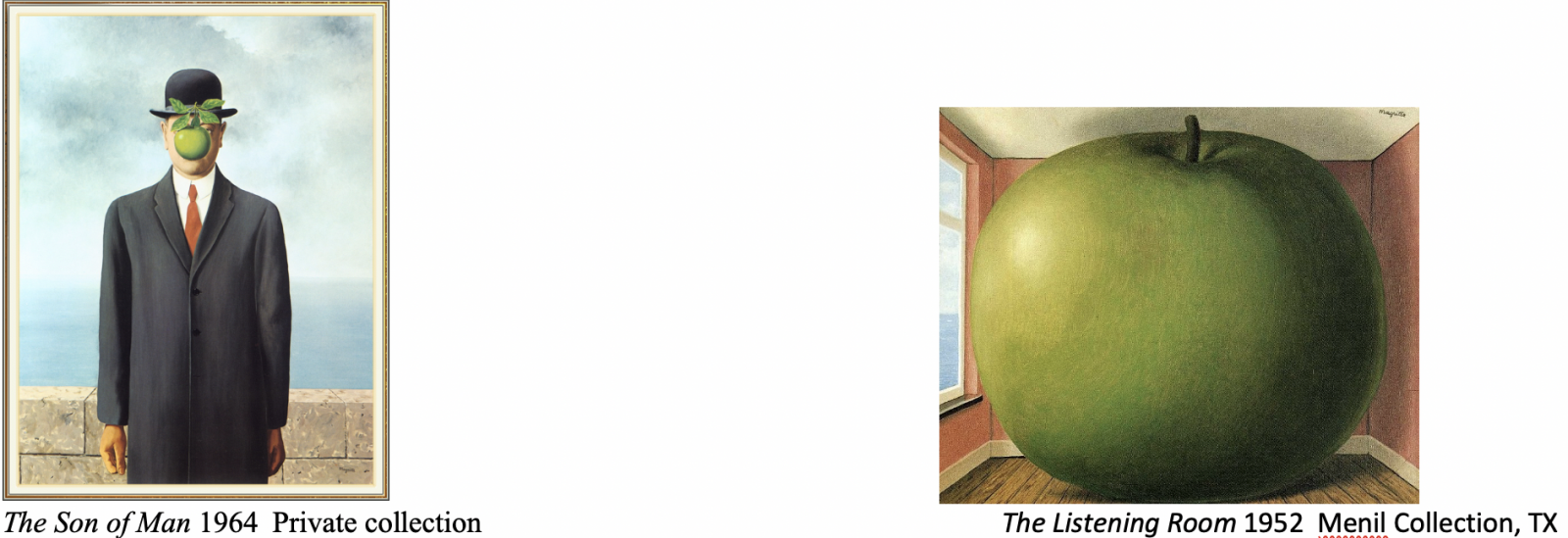Students will learn about Rene Magritte and create felt apple sculptures resembling a famous Magritte artwork. Recommended for 1st Graders.
Form: a three-dimensional object that has height, length, width, and depth.
Shape: a two-dimensional (flat) area enclosed by a line.
Balance: a sense that the sculpture feels stable, ‘feels right’. In this case, does the figure sit upright?
Proportion: the relationship of parts to a whole or parts to one another in regard to size and placement. In this lesson, are all the body parts proportional to the figure?
Felting: becoming permanently matted or entangled.
Sculpture: a three-dimensional work of art.
Surrealism: the use of fantastic imagery to combine the dreamlike with the realistic levitation.
Textile: a type of cloth or woven fabric.
René Magritte (1898-1967) was a Belgian surrealist painter. He became well known for a number of witty and thought-provoking images, often depicting ordinary objects in an unusual context. His work is known for challenging observers' preconditioned perceptions of reality. He has influenced pop, minimalist and conceptual art.

Who was Rene Magritte?
What is surrealism?
What is wool felting?
Students will be able to answer questions about art history learned about Magritte from the children’s books.
Students will create an apple sculpture with wool.
Read children’s books about Magritte to students. Observe and discuss several of Magritte’s paintings (see above). Ask open ended questions to have a group discussion about his artwork.
Children’s Books: Magrite’s Marvelous Hat: D. B Johnson; René Magritte (Getting to Know the World's Greatest Artists): Mike Venezia. Lesson written by Elizabeth Jackson; see more about Magritte at ReneMagritte.org.
21st Century Thinking Skills
Thinking flexibly, persisting, questioning, creating, innovating, listening with empathy, taking responsible risks, observing, making connections, visualizing, sequencing, predicting, comparing/contrasting, determining main idea, finding evidence, problem solving, cause and effect, determining point of view, decision making.
WA State Learning Standards:
(VA:Cr1.1.K) a. Engage in exploration and imaginative play with materials.
(VA:Cr2.2.K) a. Identify safe and non-toxic art materials, tools, and equipment.
(VA:Cr2.3.K) a. Create art that represents natural and constructed environments.
(VA:Cr3.1.K) a. Explain the process of making art while creating.
(VA:Re8.1.K) a. Interpret art by identifying subject matter and describing relevant details.
(VA:Cr1.2.1) a. Use observation and investigation in preparation for making a work of art.
(VA:Cr2.2.1) a. Demonstrate safe and proper procedures for using materials, tools, and equipment while making art.
(VA:Cn11.1.1) a. Understand that people from different places and times have made art for a variety of reasons.
(VA:Re7.1.2) a. Perceive and describe aesthetic characteristics of one’s natural world and constructed environments.
(VA:Re8.1.2) a. Interpret art by identifying the mood suggested by a work of art and describing relevant subject matter and characteristics of form.
(VA:Re7.2.3) a. Determine messages communicated by an image.
(VA:Re8.1.4) a. Interpret art by referring to contextual information and analyzing relevant subject matter, characteristics of form, and use of media.
(VA:Re7.2.5) a. Identify and analyze cultural associations suggested by visual imagery.
(VA:Cn10.1.5) a. Apply formal and conceptual vocabularies of art and design to view surroundings in new ways through art-making.
(VA:Cn11.1.5) a. Identify how art is used to inform or change beliefs, values, or behaviors of an individual or society. This happens at the 5th grade level if you discuss the purpose of surreal imagery.
Arts Integration Opportunities:
Procedural writing about the process of felting.
Spelling: Use vocabulary words at appropriate grade levels.
Community/social studies: talk about, write about how society sends messages using pictures.
Writing: what does ‘surreal’ mean?
Please note: These lesson plans are intended for non-profit use only. Use of these plans for commercial purposes should give attribution to the Issaquah Schools Foundation and be accompanied by a nominal donation at www.isfdn.org/donate. Thank you.
Fueling Success for Every Student, Every School